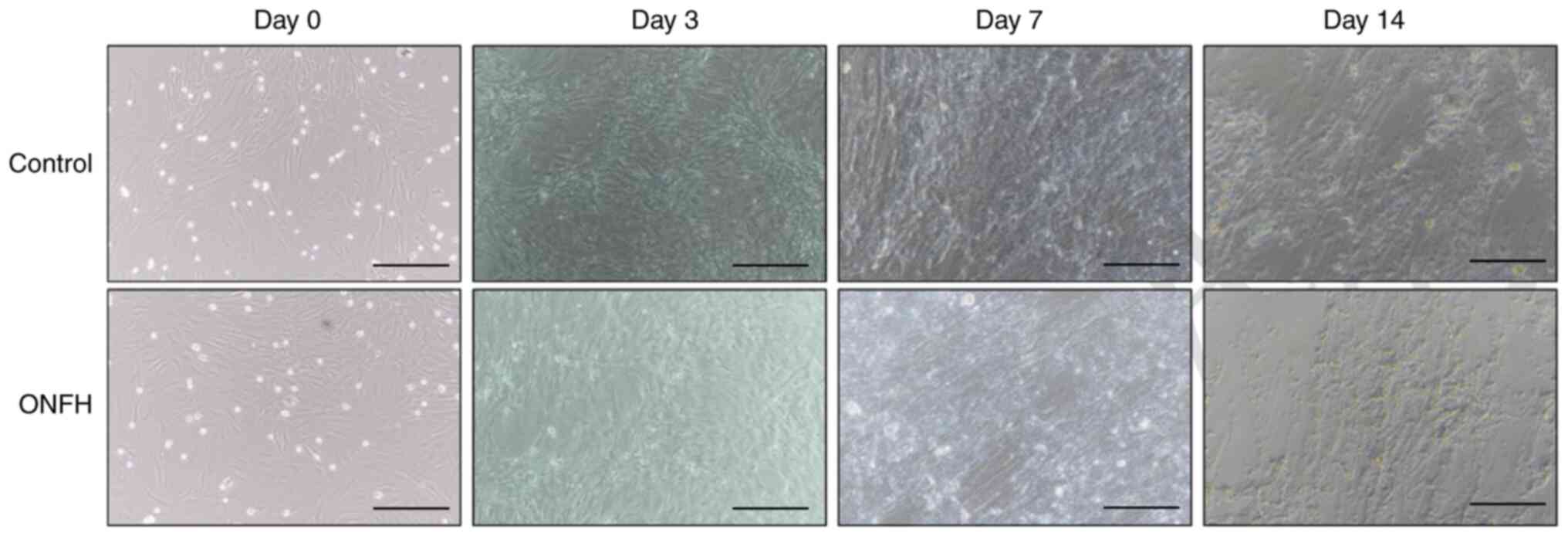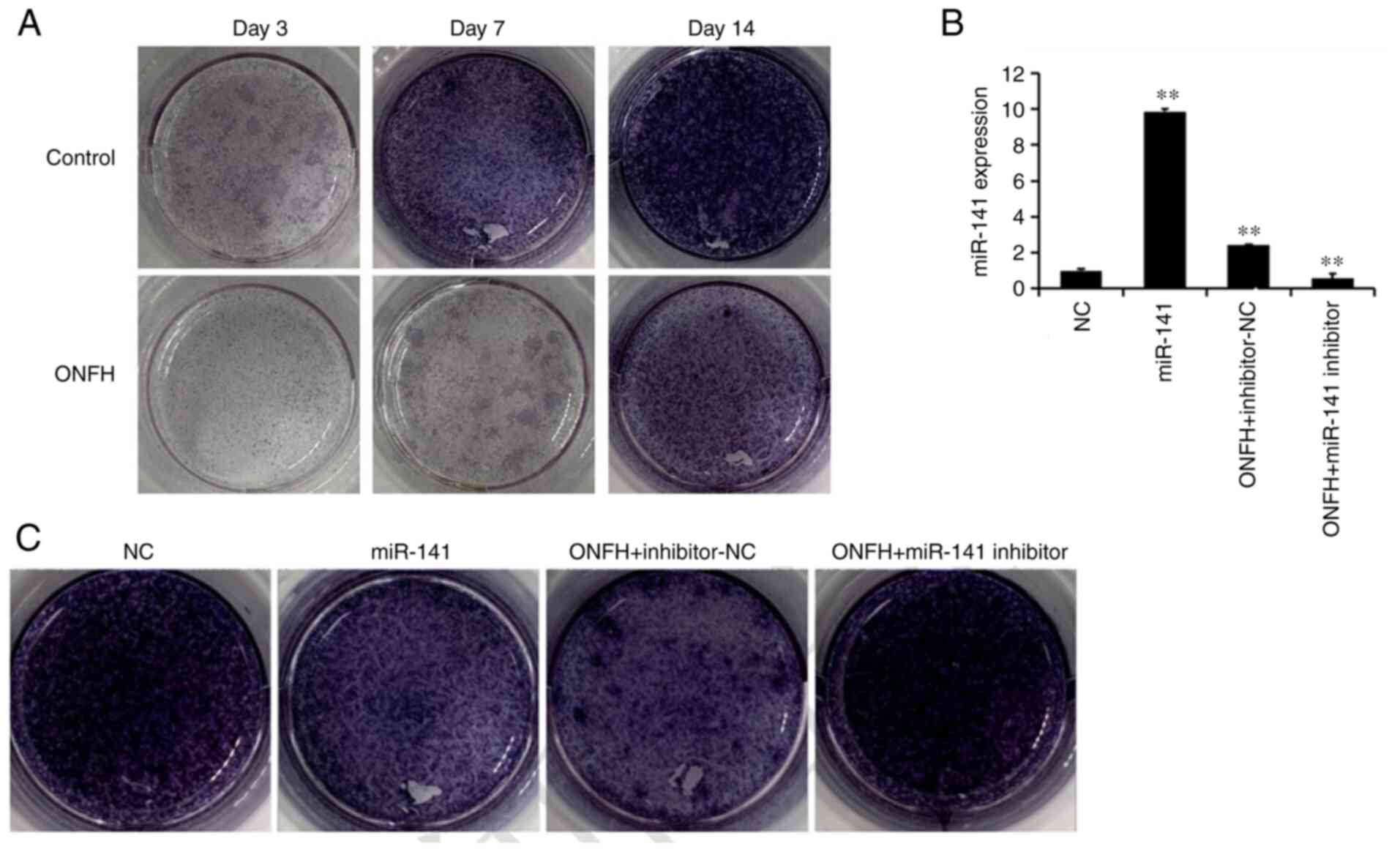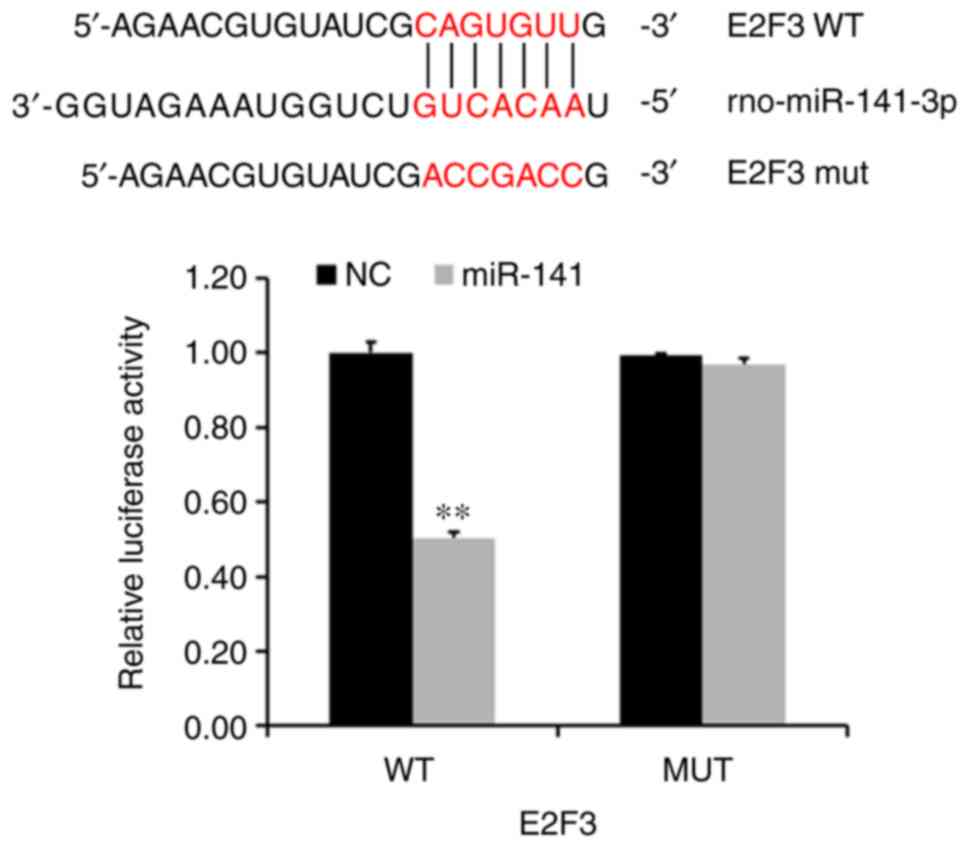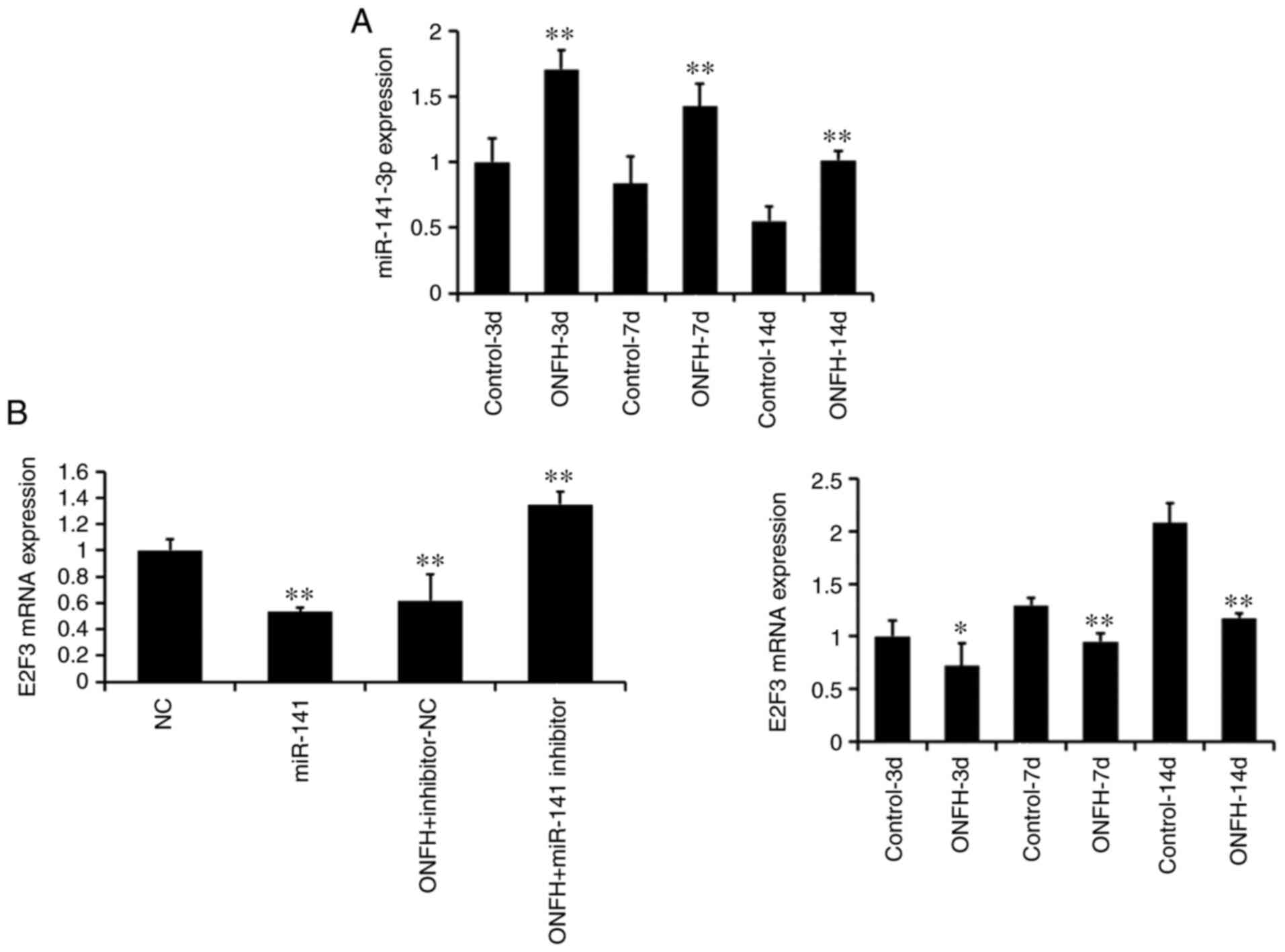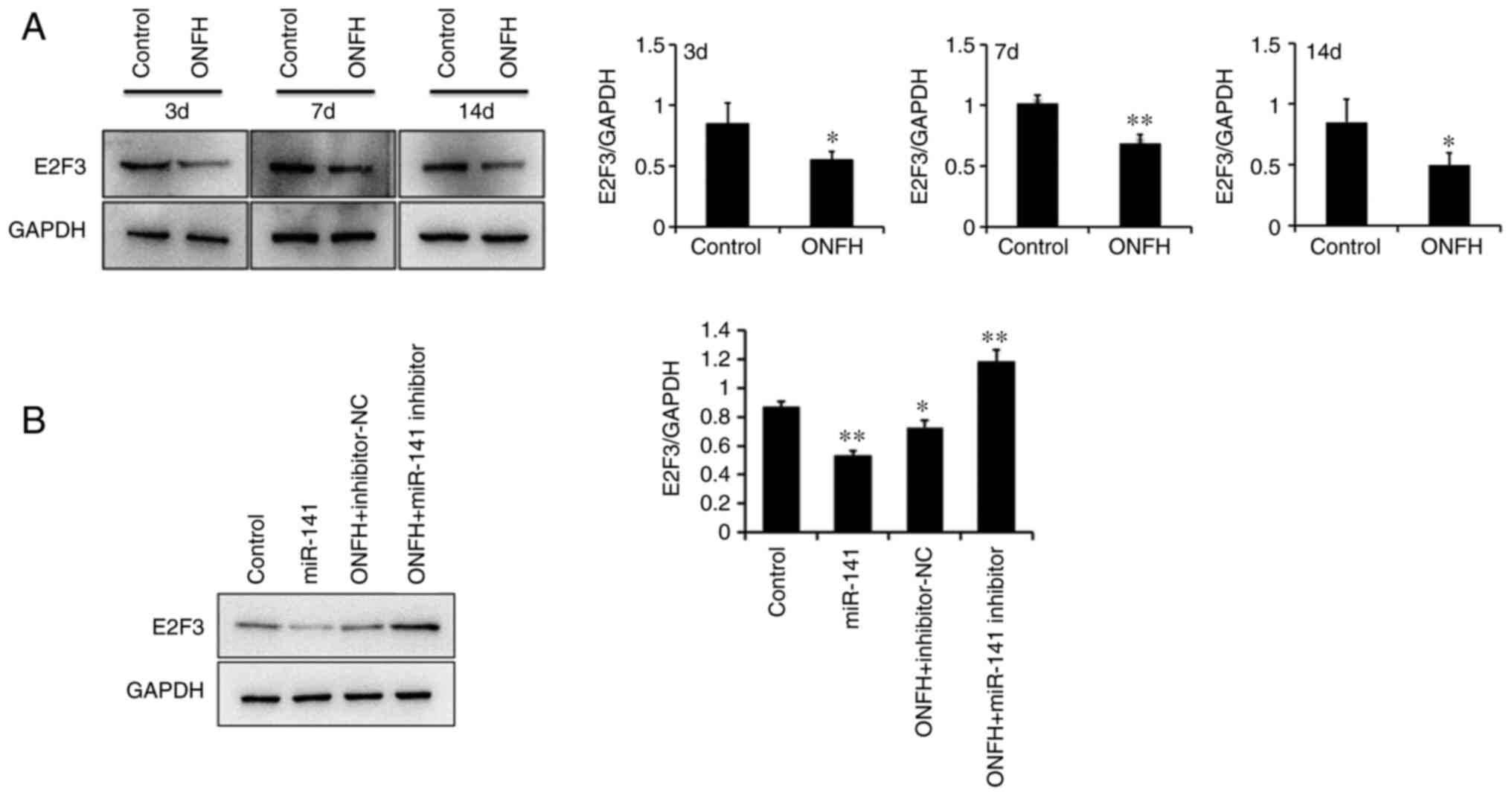|
1
|
Vreden SG, Hermus AR, van Liessum PA,
Pieters GF, Smals AG and Kloppenborg PWC: Aseptic bone necrosis in
patients on glucocorticoid replacement therapy. Neth J Med.
39:153–157. 1991.PubMed/NCBI
|
|
2
|
Shigemura T, Nakamura J, Kishida S, Harada
Y, Ohtori S, Kamikawa K, Ochiai N and Takahashi K: Incidence of
osteonecrosis associated with corticosteroid therapy among
different underlying diseases: Prospective MRI study. Rheumatology
(Oxford). 50:2023–2028. 2011. View Article : Google Scholar : PubMed/NCBI
|
|
3
|
Cui Q, Jo WL, Koo KH, Cheng EY, Drescher
W, Goodman SB, Ha YC, Hernigou P, Jones LC, Kim SY, et al: ARCO
consensus on the pathogenesis of non-traumatic osteonecrosis of the
femoral head. J Korean Med Sci. 36:e652021. View Article : Google Scholar
|
|
4
|
Liu Y, Jia Y, Cao Y, Zhao Y, Du J, An F,
Qi Y, Feng X, Jin T, Shi J and Wang J: MMP9 polymorphism is
associated with susceptibility to non-traumatic osteonecrosis of
femoral head in a Chinese Han population. Oncotarget.
8:82835–82841. 2017. View Article : Google Scholar
|
|
5
|
Liu W, Zhao Z, Na Y, Meng C, Wang J and
Bai R: Dexamethasone-induced production of reactive oxygen species
promotes apoptosis via endoplasmic reticulum stress and autophagy
in MC3T3-E1 cells. Int J Mol Med. 41:2028–2036. 2018.PubMed/NCBI
|
|
6
|
Jones JP Jr: Fat embolism, intravascular
coagulation, and osteonecrosis. Clin Orthop Relat Res. 294–308.
1993. View Article : Google Scholar
|
|
7
|
Xu X, Wen H, Hu Y, Yu H, Zhang Y, Chen C
and Pan X: STAT1-caspase 3 pathway in the apoptotic process
associated with steroid-induced necrosis of the femoral head. J Mol
Histol. 45:473–485. 2014. View Article : Google Scholar
|
|
8
|
Tack L, Tatsi C, Stratakis CA and Lodish
MB: Effects of glucocorticoids on bone: What we can learn from
pediatric endogenous cushing's syndrome. Horm Metab Res.
48:764–770. 2016. View Article : Google Scholar : PubMed/NCBI
|
|
9
|
Wu Q, Xiong X, Zhang X, Lu J, Zhang X,
Chen W, Wu T, Cui L, Liu Y and Xu B: Secondary osteoporosis in
collagen-induced arthritis rats. J Bone Miner Metab. 34:500–516.
2016. View Article : Google Scholar : PubMed/NCBI
|
|
10
|
Wu Z, Bucher NL and Farmer SR: Induction
of peroxisome proliferator-activated receptor gamma during the
conversion of 3T3 fibroblasts into adipocytes is mediated by
C/EBPbeta, C/EBPdelta, and glucocorticoids. Mol Cell Biol.
16:4128–4136. 1996. View Article : Google Scholar
|
|
11
|
Pittenger MF, Mackay AM, Beck SC, Jaiswal
RK, Douglas R, Mosca JD, Moorman MA, Simonetti DW, Craig S and
Marshak DR: Multilineage potential of adult human mesenchymal stem
cells. Science. 284:143. 1999. View Article : Google Scholar : PubMed/NCBI
|
|
12
|
Prockop DJ: Marrow stromal cells as stem
cells for nonhematopoietic tissues. Science. 276:71–74. 1997.
View Article : Google Scholar : PubMed/NCBI
|
|
13
|
Gao Y, Patil S and Jia J: The development
of molecular biology of osteoporosis. Int J Mol Sci. 22:81822021.
View Article : Google Scholar
|
|
14
|
Matsuya H, Kushida T, Asada T, Umeda M,
Wada T and Iida H: Regenerative effects of transplanting autologous
mesenchymal stem cells on corticosteroid-induced osteonecrosis in
rabbits. Mod Rheumatol. 18:132–139. 2008. View Article : Google Scholar
|
|
15
|
Tian L and Yu X: Lipid metabolism
disorders and bone dysfunction-interrelated and mutually regulated
(Review). Mol Med Rep. 12:783–794. 2015. View Article : Google Scholar : PubMed/NCBI
|
|
16
|
Lee JS, Lee JS, Roh HL, Kim CH, Jin SJ and
Suh KT: Alterations in the differentiation ability of mesenchymal
stem cells in patients with nontraumatic osteonecrosis of the
femoral head: Comparative analysis according to the risk factor. J
Orthop Res. 24:604–609. 2006. View Article : Google Scholar : PubMed/NCBI
|
|
17
|
Liu K, Wen G, Liu R, Liang XU, Feng LI and
Tao S: Research progress of the treatment of regional osteoporosis
with BMSCs transplantation. Chin J Osteoporos. 11:1203–1206.
2013.(In Chinese).
|
|
18
|
Lewis H, Lance R, Troyer D, Beydoun H,
Hadley M, Orians J, Benzine T, Madric K, Semmes OJ, Drake R and
Esquela-Kerscher A: MiR-888 is an expressed prostatic
secretions-derived microRNA that promotes prostate cell growth and
migration. Cell Cycle. 13:227–239. 2014. View Article : Google Scholar : PubMed/NCBI
|
|
19
|
Ambros V: Victor Ambros: The broad scope
of microRNAs. Interview by Caitlin Sedwick. J Cell Biol.
201:492–493. 2013. View Article : Google Scholar
|
|
20
|
Long ZH, Bai ZG, Song JN, Zheng Z, Li J,
Zhang J, Cai J, Yao HW, Wang J, Yang YC, et al: MiR-141 inhibits
proliferation and migration of colorectal cancer SW480 Cells.
Anticancer Res. 37:4345–4352. 2017.PubMed/NCBI
|
|
21
|
Hou X, Yang L, Jiang X, Liu Z, Li X, Xie
S, Li G and Liu J: Role of microRNA-141-3p in the progression and
metastasis of hepatocellular carcinoma cell. Int J Biol Macromol.
128:331–339. 2019. View Article : Google Scholar
|
|
22
|
Xu H, Mei Q, Xiong C and Zhao J:
Tumor-suppressing effects of miR-141 in human osteosarcoma. Cell
Biochem Biophys. 69:319–325. 2014. View Article : Google Scholar : PubMed/NCBI
|
|
23
|
Yaman Agaoglu F, Kovancilar M, Dizdar Y,
Darendeliler E, Holdenrieder S, Dalay N and Gezer U: Investigation
of miR-21, miR-141, and miR-221 in blood circulation of patients
with prostate cancer. Tumour Biol. 32:583–588. 2011. View Article : Google Scholar
|
|
24
|
Meng CY, Xue F, Zhao ZQ, Hao T, Guo SB and
Feng W: Influence of MicroRNA-141 on inhibition of the
proliferation of bone marrow mesenchymal stem cells in
steroid-Induced Osteonecrosis via SOX11. Orthop Surg. 12:277–285.
2020. View
Article : Google Scholar : PubMed/NCBI
|
|
25
|
Sangani R, Periyasamy-Thandavan S, Kolhe
R, Bhattacharyya MH, Chutkan N, Hunter M, Isales C, Hamrick M, Hill
WD and Fulzele S: MicroRNAs-141 and 200a regulate the SVCT2
transporter in bone marrow stromal cells. Mol Cell Endocrinol.
410:19–26. 2015. View Article : Google Scholar
|
|
26
|
Rady B, Chen Y, Vaca P, Wang Q, Wang Y,
Salmon P and Oberholzer J: Overexpression of E2F3 promotes
proliferation of functional human β cells without induction of
apoptosis. Cell Cycle. 12:2691–2702. 2013. View Article : Google Scholar : PubMed/NCBI
|
|
27
|
Xue J, Niu YF, Huang J, Peng G, Wang LX,
Yang YH and Li YQ: MiR-141 suppresses the growth and metastasis of
HCC cells by targeting E2F3. Tumour Biol. 35:12103–12107. 2014.
View Article : Google Scholar
|
|
28
|
Kim HR, Rahman FU, Kim KS, Kim EK, Cho SM,
Lee K, Moon OS, Seo YW, Yoon WK, Won YS, et al: Critical roles of
E2F3 in growth and musculo-skeletal phenotype in mice. Int J Med
Sci. 16:1557–1563. 2019. View Article : Google Scholar
|
|
29
|
Farag MR, Anter RGA, Elhady WM, Khalil SR,
Abou-Zeid SM and Hassanen EAA: Diversity, succession pattern and
colonization of forensic entomofauna on indoor rat carrions
concerning the manner of death. Rend Fis Acc Lincei. 32:521–538.
2021. View Article : Google Scholar
|
|
30
|
Yaghoobi M, Hashemi-Najafabadi S,
Soleimani M and Vasheghani-Farahani E: Osteogenic induction of
human mesenchymal stem cells in multilayered electrospun scaffolds
at different flow rates and configurations in a perfusion
bioreactor. J Biosci Bioeng. 128:495–503. 2019. View Article : Google Scholar : PubMed/NCBI
|
|
31
|
Adibkia K, Ehsani A, Jodaei A, Fathi E,
Farahzadi R and Barzegar-Jalali M: Silver nanoparticles induce the
cardiomyogenic differentiation of bone marrow derived mesenchymal
stem cells via telomere length extension. Beilstein J Nanotechnol.
12:786–797. 2021. View Article : Google Scholar
|
|
32
|
Li X, Wang L, Su Q, Ye L, Zhou X, Zhang L,
Song D and Huang D: Potential roles of bone morphogenetic protein 9
in the odontogenic differentiation of dental pulp cells. J Endod.
47:436–443. 2021. View Article : Google Scholar : PubMed/NCBI
|
|
33
|
Langkilde A, Raaby L, Johansen C and
Iversen L: MicroRNA normalization candidates for quantitative
reverse-transcriptase polymerase chain reaction in real time in
lesional and nonlesional psoriatic skin. Br J Dermatol.
169:677–681. 2013. View Article : Google Scholar
|
|
34
|
Nicolas FE: Experimental validation of
MicroRNA targets using a luciferase reporter system. Methods Mol
Biol. 732:139–152. 2011. View Article : Google Scholar
|
|
35
|
Wang Y, Sun J, Guo X, Zhang D, Cui Y, Li
W, Liu G, Li Y and Jiang S: TaqMan-based real-time polymerase chain
reaction assay for specific detection of bocavirus-1 in domestic
cats. Mol Cell Probes. 53:1016472020. View Article : Google Scholar : PubMed/NCBI
|
|
36
|
Fathi E, Farahzadi R, Vietor I and
Javanmardi S: Cardiac differentiation of bone-marrow-resident
c-kit+ stem cells by L-carnitine increases through
secretion of VEGF, IL6, IGF-1 and TGF-β. as clinical agents in
cardiac regeneration. J Biosci. 45:922020. View Article : Google Scholar
|
|
37
|
Fathi E, Farahzadi R and Valipour B:
Alginate/gelatin encapsulation promotes NK cells differentiation
potential of bone marrow resident C-kit+ hematopoietic stem cells.
Int J Biol Macromol. 177:317–327. 2021. View Article : Google Scholar
|
|
38
|
Livak KJ and Schmittgen TD: Analysis of
relative gene expression data using real-time quantitative PCR and
the 2(−Delta Delta C(T)) Method. Methods. 25:402–408. 2001.
View Article : Google Scholar : PubMed/NCBI
|
|
39
|
Kurien BT and Scofield RH: Western
blotting. Methods. 38:283–293. 2006. View Article : Google Scholar : PubMed/NCBI
|
|
40
|
Lau RL, Perruccio AV, Evans HM, Mahomed
SR, Mahomed NN and Gandhi R: Stem cell therapy for the treatment of
early stage avascular necrosis of the femoral head: A systematic
review. BMC Musculoskelet Disord. 15:1562014. View Article : Google Scholar : PubMed/NCBI
|
|
41
|
Peckett AJ, Wright DC and Riddell MC: The
effects of glucocorticoids on adipose tissue lipid metabolism.
Metabolism. 60:1500–1510. 2011. View Article : Google Scholar : PubMed/NCBI
|
|
42
|
Pansky A, Roitzheim B and Tobiasch E:
Differentiation potential of adult human mesenchymal stem cells.
Clin Lab. 53:81–84. 2011.
|
|
43
|
Yu Y, Wei N, Stanford C, Schmidt T and
Hong L: In vitro effects of RU486 on proliferation and
differentiation capabilities of human bone marrow mesenchymal
stromal cells. Steroids. 77:132–137. 2012. View Article : Google Scholar : PubMed/NCBI
|
|
44
|
Wang T, Teng S, Zhang Y, Wang F, Ding H
and Guo L: Role of mesenchymal stem cells on differentiation in
steroid-induced avascular necrosis of the femoral head. Exp Ther
Med. 13:669–675. 2017. View Article : Google Scholar : PubMed/NCBI
|
|
45
|
Bai R, Feng W, Liu WL, Zhao ZH, Zhao AQ,
Wang Y, Wang WX, Sun L, Wu LS and Cui SH: Roles of osteocyte
apoptosis in steroid-induced avascular necrosis of the femoral
head. Genet Mol Res. 15:2016. View Article : Google Scholar
|
|
46
|
Wang J, Liu S, Li J, Zhao S and Yi Z:
Roles for miRNAs in osteogenic differentiation of bone marrow
mesenchymal stem cells. Stem Cell Res Ther. 10:1972019. View Article : Google Scholar : PubMed/NCBI
|
|
47
|
de Almeida DC, Bassi ÊJ, Azevedo H,
Anderson L, Origassa CS, Cenedeze MA, de Andrade-Oliveira V,
Felizardo RJ, da Silva RC, Hiyane MI, et al: A Regulatory
miRNA-mRNA network is associated with tissue repair induced by
mesenchymal stromal cells in acute kidney injury. Front Immunol.
7:6452017. View Article : Google Scholar
|
|
48
|
Yu KR, Lee S, Jung JW, Hong IS, Kim HS,
Seo Y, Shin TH and Kang KS: MicroRNA-141-3p plays a role in human
mesenchymal stem cell aging by directly targeting ZMPSTE24. J Cell
Sci. 126((Pt 23)): 5422–5431. 2013.
|
|
49
|
Neves R, Scheel C, Weinhold S, Honisch E,
Iwaniuk KM, Trompeter HI, Niederacher D, Wernet P, Santourlidis S
and Uhrberg M: Role of DNA methylation in miR-200c/141 cluster
silencing in invasive breast cancer cells. BMC Res Notes.
3:2192010. View Article : Google Scholar : PubMed/NCBI
|
|
50
|
Pizzini S, Bisognin A, Mandruzzato S,
Biasiolo M, Facciolli A, Perilli L, Rossi E, Esposito G, Rugge M,
Pilati P, et al: Impact of microRNAs on regulatory networks and
pathways in human colorectal carcinogenesis and development of
metastasis. BMC Genomics. 14:5892013. View Article : Google Scholar : PubMed/NCBI
|
|
51
|
Miles WO, Tschop K, Herr A, Ji JY and
Dyson NJ: Pumilio facilitates miRNA regulation of the E2F3
oncogene. Genes Dev. 26:356–368. 2012. View Article : Google Scholar : PubMed/NCBI
|
|
52
|
Zeng X, Yin F, Liu X, Xu J, Xu Y, Huang J,
Nan Y and Qiu X: Upregulation of E2F transcription factor 3 is
associated with poor prognosis in hepatocellular carcinoma. Oncol
Rep. 31:1139–1146. 2014. View Article : Google Scholar : PubMed/NCBI
|
|
53
|
Bilke S, Schwentner R, Yang F, Kauer M,
Jug G, Walker RL, Davis S, Zhu YJ, Pineda M, Meltzer PS and Kovar
H: Oncogenic ETS fusions deregulate E2F3 target genes in Ewing
sarcoma and prostate cancer. Genome Res. 23:1797–1809. 2013.
View Article : Google Scholar : PubMed/NCBI
|















